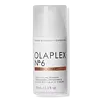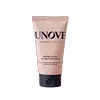What's inside
What's inside
 Key Ingredients
Key Ingredients

 Benefits
Benefits

 Concerns
Concerns

 Ingredients Side-by-side
Ingredients Side-by-side

Water
Skin ConditioningCetearyl Alcohol
EmollientDimethicone
EmollientIsohexadecane
EmollientCoco-Caprylate
EmollientNeopentyl Glycol Diheptanoate
EmollientBehentrimonium Chloride
PreservativeIsododecane
EmollientPhenyl Trimethicone
Skin ConditioningPropanediol
SolventBis-Aminopropyl Diglycol Dimaleate
Skin ConditioningParfum
MaskingCetrimonium Chloride
AntimicrobialPhenoxyethanol
PreservativeGlyceryl Stearate
EmollientIsopropyl Alcohol
SolventHydroxyethylcellulose
Emulsion StabilisingHydroxypropyl Guar
Emulsion StabilisingSodium Stearoyl Lactylate
EmulsifyingHydroxypropyl Cyclodextrin
MaskingHexyl Cinnamal
PerfumingLimonene
PerfumingCitral
PerfumingHydrolyzed Vegetable Protein Pg-Propyl Silanetriol
Skin ConditioningDisodium EDTA
Linalool
PerfumingCitronellol
PerfumingIodopropynyl Butylcarbamate
PreservativeHydroxycitronellal
PerfumingEtidronic Acid
Tocopherol
AntioxidantGeraniol
PerfumingPotassium Sorbate
PreservativeHelianthus Annuus Seed Oil
EmollientPhytantriol
HumectantSodium Benzoate
MaskingPseudozyma Epicola/Camellia Sinensis Seed Oil Ferment Extract Filtrate
HumectantTocopheryl Acetate
AntioxidantVitis Vinifera Seed Oil
EmollientAloe Barbadensis Leaf Juice
Skin ConditioningPanthenol
Skin ConditioningCitric Acid
BufferingGigartina Stellata Extract
Skin ProtectingChondrus Crispus Extract
Skin ConditioningAscorbic Acid
AntioxidantCocos Nucifera Oil
MaskingWater, Cetearyl Alcohol, Dimethicone, Isohexadecane, Coco-Caprylate, Neopentyl Glycol Diheptanoate, Behentrimonium Chloride, Isododecane, Phenyl Trimethicone, Propanediol, Bis-Aminopropyl Diglycol Dimaleate, Parfum, Cetrimonium Chloride, Phenoxyethanol, Glyceryl Stearate, Isopropyl Alcohol, Hydroxyethylcellulose, Hydroxypropyl Guar, Sodium Stearoyl Lactylate, Hydroxypropyl Cyclodextrin, Hexyl Cinnamal, Limonene, Citral, Hydrolyzed Vegetable Protein Pg-Propyl Silanetriol, Disodium EDTA, Linalool, Citronellol, Iodopropynyl Butylcarbamate, Hydroxycitronellal, Etidronic Acid, Tocopherol, Geraniol, Potassium Sorbate, Helianthus Annuus Seed Oil, Phytantriol, Sodium Benzoate, Pseudozyma Epicola/Camellia Sinensis Seed Oil Ferment Extract Filtrate, Tocopheryl Acetate, Vitis Vinifera Seed Oil, Aloe Barbadensis Leaf Juice, Panthenol, Citric Acid, Gigartina Stellata Extract, Chondrus Crispus Extract, Ascorbic Acid, Cocos Nucifera Oil
Glycerin
HumectantWater
Skin ConditioningDimethicone
EmollientMyristyl Alcohol
EmollientCamellia Japonica Seed Oil
EmollientSteartrimonium Chloride
PreservativeParfum
MaskingPropylene Glycol
HumectantDipropylene Glycol
HumectantCaprylyl Glycol
EmollientTocopheryl Acetate
AntioxidantHydroxyacetophenone
AntioxidantHexyl Cinnamal
PerfumingC12-15 Pareth-3
EmulsifyingGuar Hydroxypropyltrimonium Chloride
Skin ConditioningDisodium EDTA
Cocamidopropyl Betaine
CleansingPhenoxyethanol
PreservativePolyquaternium-7
Salicylic Acid
MaskingGeraniol
PerfumingCitronellol
PerfumingLimonene
PerfumingSodium Hydroxide
BufferingSodium Benzoate
MaskingHydrolyzed Keratin
HumectantAlpha-Isomethyl Ionone
PerfumingArgania Spinosa Kernel Oil
EmollientOlea Europaea Fruit Oil
MaskingMacadamia Integrifolia Seed Oil
Skin ConditioningHelianthus Annuus Seed Oil
EmollientHydrolyzed Milk Protein
Skin ConditioningHydrolyzed Collagen
EmollientHydrolyzed Silk
HumectantButylene Glycol
Humectant1,2-Hexanediol
Skin ConditioningCysteine
AntioxidantSilk Amino Acids
HumectantEthyl Hexanediol
SolventEthylhexylglycerin
Skin ConditioningHydrolyzed Corn Protein
Skin ConditioningHydrolyzed Wheat Protein
Skin ConditioningHydrolyzed Soy Protein
HumectantLeucine
Skin ConditioningValine
MaskingIsoleucine
Skin ConditioningTaurine
BufferingAspartic Acid
MaskingOrnithine
Skin ConditioningGlutamic Acid
HumectantGlycine
BufferingGlutamine
Skin ConditioningLysine
Skin ConditioningMethionine
Skin ConditioningSerine
MaskingCystine
MaskingAsparagine
MaskingAlanine
MaskingArginine
MaskingTyrosine
MaskingThreonine
Tryptophan
MaskingPhenylalanine
MaskingProline
Skin ConditioningHistidine
HumectantGlycerin, Water, Dimethicone, Myristyl Alcohol, Camellia Japonica Seed Oil, Steartrimonium Chloride, Parfum, Propylene Glycol, Dipropylene Glycol, Caprylyl Glycol, Tocopheryl Acetate, Hydroxyacetophenone, Hexyl Cinnamal, C12-15 Pareth-3, Guar Hydroxypropyltrimonium Chloride, Disodium EDTA, Cocamidopropyl Betaine, Phenoxyethanol, Polyquaternium-7, Salicylic Acid, Geraniol, Citronellol, Limonene, Sodium Hydroxide, Sodium Benzoate, Hydrolyzed Keratin, Alpha-Isomethyl Ionone, Argania Spinosa Kernel Oil, Olea Europaea Fruit Oil, Macadamia Integrifolia Seed Oil, Helianthus Annuus Seed Oil, Hydrolyzed Milk Protein, Hydrolyzed Collagen, Hydrolyzed Silk, Butylene Glycol, 1,2-Hexanediol, Cysteine, Silk Amino Acids, Ethyl Hexanediol, Ethylhexylglycerin, Hydrolyzed Corn Protein, Hydrolyzed Wheat Protein, Hydrolyzed Soy Protein, Leucine, Valine, Isoleucine, Taurine, Aspartic Acid, Ornithine, Glutamic Acid, Glycine, Glutamine, Lysine, Methionine, Serine, Cystine, Asparagine, Alanine, Arginine, Tyrosine, Threonine, Tryptophan, Phenylalanine, Proline, Histidine
 Reviews
Reviews

Ingredients Explained
These ingredients are found in both products.
Ingredients higher up in an ingredient list are typically present in a larger amount.
Citronellol is used to add fragrance/parfum to a product. It is often derived from plants such as roses. In fact, it can be found in many essential oils including geranium, lavender, neroli, and more. The scent of Citronellol is often described as "fresh, grassy, and citrus-like".
Since the Citronellol molecule is already unstable, Citronellol becomes irritating on the skin when exposed to air.
Citronellol is a modified terpene. Terpenes are unsaturated hydrocarbons found in plants. They make up the primary part of essential oils.
Citronellol is not able to be absorbed into deeper layers of the skin. It has low permeability,
Citronellol is also a natural insect repellent.
Learn more about CitronellolDimethicone is a type of synthetic silicone created from natural materials such as quartz.
What it does:
Dimethicone comes in different viscosities:
Depending on the viscosity, dimethicone has different properties.
Ingredients lists don't always show which type is used, so we recommend reaching out to the brand if you have questions about the viscosity.
This ingredient is unlikely to cause irritation because it does not get absorbed into skin. However, people with silicone allergies should be careful about using this ingredient.
Note: Dimethicone may contribute to pilling. This is because it is not oil or water soluble, so pilling may occur when layered with products. When mixed with heavy oils in a formula, the outcome is also quite greasy.
Learn more about DimethiconeDisodium EDTA plays a role in making products more stable by aiding other preservatives.
It is a chelating agent, meaning it neutralizes metal ions that may be found in a product.
Disodium EDTA is a salt of edetic acid and is found to be safe in cosmetic ingredients.
Learn more about Disodium EDTAGeraniol is used to add fragrance/parfum to a product. It is the main component of citronellol. It is a monoterpenoid and an alcohol.
Monoterpenes are naturally found in many parts of different plants.
Geraniol can be found in many essential oils including Rose Oil and Citronella Oil. The scent of Geraniol is often described as "rose-like". Many foods also contain Geraniol for fruit flavoring.
Geraniol can irritate the skin when exposed to air. However, irritation depends on the ability of geraniol to penetrate into the skin. In general, geraniol is not able to penetrate skin easily.
Geraniol is colorless and has low water-solubility. However, it is soluble in common organic solvents.
Like citronellol, it is a natural insect repellent.
2,6-Octadien-1-ol, 3,7-dimethyl-, (2E)-
Learn more about GeraniolHelianthus Annuus Seed Oil is the oil derived from the seeds of a Sunflower. Sunflower seed oil is non-fragrant. It is an emollient, meaning it helps to soften the skin.
Sunflower seed oil contains many fatty acids. The fatty acids found in sunflower seeds include (from highest amount to least): linoleic acid, myristic acid, palmitic acid, stearic acid, arachidic acid, oleic acid, and linolenic acid.
These fatty acids help the skin create ceramides. Ceramides play a role in repairing the skin barrier.
Helianthus Annuus Seed Oil helps moisturize the skin. This in turn helps the skin look more rejuvenated and smoother.
Sunflowers are rich in vitamin E.
Historians believe Indigenous cultures of North America domesticated sunflowers before corn. Thus they relied on sunflower oil for a variety of uses. One such use is moisturizing skin and hair.
Sunflower seed oil may not be fungal acne safe. We recommend speaking with a professional if you have any concerns.
Learn more about Helianthus Annuus Seed OilHexyl Cinnamal is a fragrance ingredient with a similar scent to jasmine. It can be naturally found in chamomile essential oil.
This ingredient is a known EU allergen and may sensitize the skin. The EU requires this ingredient to be listed separately on an ingredients list.
Hexyl Cinnamal is not water soluble but is soluble in oils.
Learn more about Hexyl CinnamalLimonene is a fragrance that adds scent and taste to a formulation.
It's found in the peel oil of citrus fruits and other plants such as lavender and eucalyptus. The scent of limonene is generally described as "sweet citrus".
Limonene acts as an antioxidant, meaning it helps neutralize free radicals.
When exposed to air, oxidized limonene may sensitize the skin. Because of this, limonene is often avoided by people with sensitive skin.
The term 'fragrance' is not regulated in many countries. In many cases, it is up to the brand to define this term. For instance, many brands choose to label themselves as "fragrance-free" because they are not using synthetic fragrances. However, their products may still contain ingredients such as essential oils that are considered a fragrance.
Learn more about LimoneneParfum is a catch-all term for an ingredient or more that is used to give a scent to products.
Also called "fragrance", this ingredient can be a blend of hundreds of chemicals or plant oils. This means every product with "fragrance" or "parfum" in the ingredients list is a different mixture.
For instance, Habanolide is a proprietary trade name for a specific aroma chemical. When used as a fragrance ingredient in cosmetics, most aroma chemicals fall under the broad labeling category of “FRAGRANCE” or “PARFUM” according to EU and US regulations.
The term 'parfum' or 'fragrance' is not regulated in many countries. In many cases, it is up to the brand to define this term.
For instance, many brands choose to label themselves as "fragrance-free" because they are not using synthetic fragrances. However, their products may still contain ingredients such as essential oils that are considered a fragrance by INCI standards.
One example is Calendula flower extract. Calendula is an essential oil that still imparts a scent or 'fragrance'.
Depending on the blend, the ingredients in the mixture can cause allergies and sensitivities on the skin. Some ingredients that are known EU allergens include linalool and citronellol.
Parfum can also be used to mask or cover an unpleasant scent.
The bottom line is: not all fragrances/parfum/ingredients are created equally. If you are worried about fragrances, we recommend taking a closer look at an ingredient. And of course, we always recommend speaking with a professional.
Learn more about ParfumPhenoxyethanol is a preservative that has germicide, antimicrobial, and aromatic properties. Studies show that phenoxyethanol can prevent microbial growth. By itself, it has a scent that is similar to that of a rose.
It's often used in formulations along with Caprylyl Glycol to preserve the shelf life of products.
Sodium Benzoate is a preservative. It's used in both cosmetic and food products to inhibit the growth of mold and bacteria. It is typically produced synthetically.
Both the US FDA and EU Health Committee have approved the use of sodium benzoate. In the US, levels of 0.1% (of the total product) are allowed.
Sodium benzoate works as a preservative by inhibiting the growth of bacteria inside of cells. It prevents the cell from fermenting a type of sugar using an enzyme called phosphofructokinase.
It is the salt of benzoic acid. Foods containing sodium benzoate include soda, salad dressings, condiments, fruit juices, wines, and snack foods.
Studies for using ascorbic acid and sodium benzoate in cosmetics are lacking, especially in skincare routines with multiple steps.
We always recommend speaking with a professional, such as a dermatologist, if you have any concerns.
Learn more about Sodium BenzoateTocopheryl Acetate is AKA Vitamin E. It is an antioxidant and protects your skin from free radicals. Free radicals damage the skin by breaking down collagen.
One study found using Tocopheryl Acetate with Vitamin C decreased the number of sunburned cells.
Tocopheryl Acetate is commonly found in both skincare and dietary supplements.
Learn more about Tocopheryl AcetateWater. It's the most common cosmetic ingredient of all. You'll usually see it at the top of ingredient lists, meaning that it makes up the largest part of the product.
So why is it so popular? Water most often acts as a solvent - this means that it helps dissolve other ingredients into the formulation.
You'll also recognize water as that liquid we all need to stay alive. If you see this, drink a glass of water. Stay hydrated!
Learn more about Water